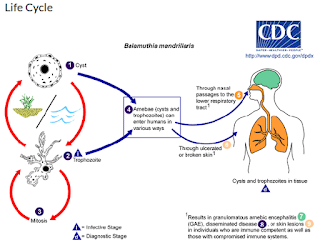#13,562
My thanks to Amoeba-Season.com for tweeting the link to a truly fascinating soon-to-be published report on medical mystery worthy of House M.D. - which ended up being due to a brain infection from an extremely rare free-living amoeba called Balamuthia mandrillaris - and which ultimately proved fatal.
Regular readers of this blog already know about Nagleria floweri (see It's Naegleria Season) - another free-living amoeba which is found in warm fresh-water lakes, streams, water parks (and occasionally, tap water).
Dubbed the `brain eating amoeba' by the press - this infection is called PAM (Primary amebic meningoencephalitis) - and occurs when the amoeba enters the brain through the nasal passages, usually due to the forceful aspiration of contaminated water into the nose.Although we generally only hear about 3 or 4 cases in the United States each summer, last December in EID Journal: Estimation of Undiagnosed Naegleria fowleri (PAM), United States, a research letter written by epidemiologists from the CDC estimated the yearly number PAM cases in the United States probably averages closer to 16 (8 males, 8 females).
Meaning that right now, 70%-80% likely go unrecognized.In 2011 we saw two cases reported in Neti pot users from Louisiana, prompting the Louisiana Health Department to recommend that people `use distilled, sterile or previously boiled water to make up the irrigation solution’ (see Neti Pots & Naegleria Fowleri).
 |
| Photo Credit – Wikipedia Commons |
While rare in the United States, every year Pakistan reports a dozen or more infections from this `killer amoeba’, as chlorination of their water supplies is often inadequate, and for many, nasal ablutions are part of their daily ritual.Less well known is Balamuthia mandrillaris, which the CDC describes as:
. . . a free-living ameba (a single-celled living organism) found in the environment. It is one of the causes of granulomatous amebic encephalitis (GAE), a serious infection of the brain and spinal cord 1,2,5,6. Balamuthia is thought to enter the body when soil containing Balamuthia comes in contact with skin wounds and cuts, or when dust containing Balamuthia is breathed in or gets in the mouth 1,2. The Balamuthia amebas can then travel to the brain through the blood stream and cause GAE 4. GAE is a very rare disease that is usually fatal.Most cases, unfortunately, are only diagnosed after death. As with Naegleria, infection carries an extremely high fatality rate, but early treatment with some drugs (including miltefosine) have shown promise.
Scientists at the Centers for Disease Control and Prevention (CDC) first discovered Balamuthia mandrillaris in 1986. The ameba was found in the brain of a dead mandrill baboon 2,7. After extensive research, B. mandrillaris was declared a new species of ameba in 1993 7. Since then, more than 200 cases of Balamuthia infection have been diagnosed worldwide, with at least 70 cases reported in the United States 2. Little is known at this time about how a person becomes infected 1, 3.
The accepted manuscript (link below) is very much worth reading in its entirety, as it describes this patient's unfortunate journey in detail. Highly recommended.
Accepted Manuscript
Title: Fatal Balamuthia mandrillaris brain infection associated with improper nasal lavage
Authors: Keenan J. Piper, Haidn Foster, Daniel Susanto, Cynthia L. Maree, Sean D. Thornton, Charles S. Cobbs
PII: S1201-9712(18)34525-9
DOI: https://doi.org/10.1016/j.ijid.2018.09.013
Reference: IJID 3339
Piper Keenan J, Foster Haidn, Susanto Daniel, Maree Cynthia L, Thornton Sean D, Cobbs Charles S. Fatal Balamuthia mandrillaris brain infection associated with improper nasal lavage. International Journal of Infectious Diseases (2018), https://doi.org/10.1016/j.ijid.2018.09.013
This appears to be the first case linked to improper nasal lavage, but - as with Naegleria - Balamjuthia infection is likely under diagnosed.
The lesson here is, even if you have chlorinated tap water (see Louisiana: St. Bernard Parish Water Supply Tests Positive For Naegleria Fowleri), ALWAYS use use distilled, sterile or previously boiled water for nasal irrigation.And when you go swimming, heed the State of Florida's advice on Naegleria. Their Primary Amebic Meningoencephalitis (PAM) website recommends:
The only known way to prevent Naegleria fowleri infections is to refrain from water-related activities. However, some common-sense measures that might reduce risk by limiting the chance of contaminated water going up the nose include:
(Continue . . . )
- Avoiding water-related activities in bodies of warm freshwater, hot springs, and thermally-polluted water such as water around power plants.
- Avoiding water-related activities in warm freshwater during periods of high water temperature and low water levels.
- Holding the nose shut or using nose clips when taking part in water-related activities in bodies of warm freshwater such as lakes, rivers, or hot springs.
- Avoiding digging or stirring up sediment while taking part in water-related activities in shallow, warm freshwater areas.
Recreational water users should assume that there is always a low-level of risk associated with entering all warm fresh water in southern tier states. Because the location and number of ameba in the water can vary a lot over time, posting signs is unlikely to be an effective way to prevent infections. In addition, posting signs on only some fresh water bodies might create a misconception that bodies of water that are not posted are Naegleria-free.
And for more on the science, and on how to avoid these largely preventable tragedies, I heartily recommend following Amoeba-Season.com on twitter.
